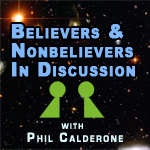I had therefore to remove knowledge, in order to make room for belief. -Immanuel KantEither a piece of information is true or it is not. There may be two sides to an argument but not to a fact. In a debate where one side is arguing for the truth and the other something false, the truth side should win. Unfortunately life is not that simple. Issues can be guarded by ideology, belief, self-interest and occasionally deceit. Any of these may be at work on a wrong-side argument but today I want to focus on belief, in particular the length that some may go to when defending an indefensible position, a position contrary to evidence. The discussion would be complicated with a nuanced topic where positions are not black and white, but to make the broad point let’s go with a simple true-false scenario—one side is right, the other wrong. Here’s a fun example to illustrate the point. A tree in a yard is the biggest of all the trees on the property. It is located ten feet from the back of a house in a beautiful mountaintop community. Does the tree contain a sentient mind or does it not? On the no side an investigator (aka NoMind) sites the knowledge that in all known Earth species, sentience requires a mind which requires a brain. This tree as with all trees has no nervous system, no brain thus no mind and no sentience. On the counter side, Neighbor takes the stance that because all living things feel this tree must feel, and that because it feels it must have a mind, thus it is sentient. He further believes that it is likely the tree is aware of its surroundings, perhaps seeing itself as a sentinel for the house, a predestined purpose. How can we judge these contrary positions? The NoMind position is based on a compilation of relevant facts about similar trees and species. To apply experimentation he can cut off a sample and examine it microscopically, comparing its cell structure to known cells of all types of which we know their function. Similarly he can test its ability to react to stimuli and to transmit electrical and chemical impulses, something we know is required for mental functioning. All together, he can compile evidence that it is indeed a mindless plant. That being so he can then make further predictions–it is unable to feel pain, has no knowledge of its nearby plants, is unaware of its insect inhabitants (though can react to them chemically as a protective process), does not spend its time pondering theories of the origin of the universe, and has no opinion about the 2016 presidential race. On the yes-mind side Neighbor will first also apply the same relevant facts and experiments but to no positive avail for his cause. However this neighbor feels intuitively that all living things have awareness. He wants to believe in tree minds, sentience and purpose so presses on to make the case in other ways. He accuses NoMind of bad experimental technique, saying that it’s likely NoMind took a non-representative bore sample. Also it is possible that plant’s nervous system is whole-organism, using intracellular chemical communication such that its brain/mind is emergent, totally unlike animal brains of nerve cell clusters. NoMind is insulted by the accusation of bad technique but yields the possibility, as least having non-zero probability. He’s not buying the whole-organism argument though, seeing it as a far-fetched idea with no basis beyond speculative concept. Having made a sliver of progress, Neighbor then attempts to bolter his side of the ledger by adding that, precisely because the physical evidence was negative, the tree’s mind must exist in a non-physical plane, unobservable through science. NoMind points out that this is a gap argument; it no more proves that the tree has a mind than it has a parallel universe unicorn admirer. So then Neighbor argues that the plant feels because all living organisms feel, else they wouldn’t be alive. NoMind points out that this is a circular argument–using something to prove itself, a logical fallacy. Frustrated but undaunted, Neighbor does some research and finds a 1972 study that concluded after meticulous measurement and calculation, that after a tree was uprooted it weighed 21 grams less. This difference was evidence of a mind having left its trunk, something that therefore existed during its life. In response NoMind suggests that it is more likely that the 21 gram loss was so small as to be within the margin of measurement error given the large mass of a tree body. Another more likely hypothesis would be that a tree starts to immediately lose water weight by evaporation, now not being able to replenish it, assuming it is not placed in a water bath or vapor-saturated atmosphere. And by the way, if 21 grams of mass was lost and that represented the mind, wouldn’t that make the mind physical? Neighbor ignores that last comment and changes tactics. He next does an experiment removing a nearby bush, noting a month later that the tree sprouts a branch into that space, thus giving evidence of both awareness of his plant colleague and perhaps even a desire to rebalance local entropy by acting to refill that space. Unconvinced, NoMind retorts that tree experts, after decades of study have concluded that trees only have sense processes to measure temperature, humidity and chemicals, processes that do not extend beyond the tree’s bark or leaf cellular pores. NoMind also reminds neighbor that the tree and its environment, actually extending to the Sun as the supplier of light, is an open system thus not restricted by changes in local entropy; laws of physics allow for local fluctuations within an open system, even organized reversal. Not wanting to delve deeper into physics and debate that last point, neighbor concedes the retort. He then goes off and launches a Kickstarter campaign to fund the more expensive experiment of removing the house, ultimately concluding that the tree, after a time of emotional adjustment, decided to repurpose itself to guard a nearby rock, this being evidence not only of sentience but of free will and intent. Though disturbed by the highly elaborate, if not inconsiderate act of dismantling someone else’s house, NoMind simply says to Neighbor, “Now you’re just making stuff up.” Neighbor, disappointed in his failure to bring NoMind to his opinion but, after all these angles of investigation and argument, even more convinced of his position exclaims, “I can’t prove it; it’s just what I believe.” NoMind responds by noting that Neighbor has failed to substantiate his claim. Given strong evidence to the contrary, the best conclusion is that this tree is not sentient. Finally Neighbor exclaims that they will have to agree to disagree, quickly leaving the room before NoMind has another chance to respond. He goes home to water and talk to his plants. — To an outside observer the evidenced side had the correct answer, the belief side a losing position that was defended by any means possible. For the believer many tools are available to avoid giving up—rationalization, evasion, misinformation (intentional or not), denial, fallacy, diversion, counter-attack, presupposition, etc. Though initial arguments may at least sound feasible when these fail subsequent arguments are weaker, assuming the strongest techniques are used first. To detach ourselves further remove the topic and imagine being on a debate team, having been randomly assigned a side. Defense of a position supported by evidence is easy and quick, while defense of the opposing view is a sequence of strategies and techniques. The complication in defending a belief is that the defender is honest and sincere, often unaware of their argument flaws. Without evidence the position is doomed to either losing (conceding) or standing on purely speculative ground, however the persistence of a strong belief will not fathom a loss since that would negate the belief. The end position thus becomes the indefensible “I just believe.” This does not bode well for future success beyond back-pats from same-minded supporters. The best aftermath of a debate loss is to step back, question ones position, reexamine the winning argument and evidence, and reconsider the result. In other words, learn from ones mistake. Unfortunately some cannot bring themselves to do this so they instead double-down on their belief, sometimes labeling their opponent as closed-minded (for not accepting a belief-based notion or giving its consideration full equivalence) and accusing them of ivory-tower arrogance. Cognitive dissonance settles in and life goes on for them, a hardened opinion thought of as fact. The effect on society is exactly what we have seen in the last thirty years—tribalism of information and conclusions. When conclusions are not allowed to be questioned, false information can reign and be carried forward generation after generation. Society becomes unable to ferret out its errors, leaving it susceptible to others who do. Belief is no way to run your life in the 21st century. It is simply outdated, an evolutionary shortcut that helps us get through the day without having to consider every analytical angle. It developed as a quick-reaction best guess that yielded survival more often than not. But it does not mean truth. In fact by definition it is often independent of it. In this century after 50,000 years of modern human existence, 5,000 years of written history, the same years of cumulative knowledge of science, engineering and mathematics we are no longer limited to belief. It is time to elevate our goal to truth. As Carl Sagan once said, “I don’t want to believe, I want to know.”

BNB19 Riverside Interfaith Council meets Inland Empire Atheists and Agnostics
The Riverside Interfaith Council meets with the Inland Empire Atheists and Agnostics for a friendly, ear-opening conversation at a local coffee house. (This post under


